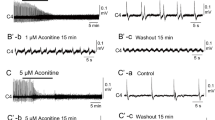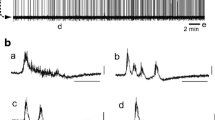Abstract
The action of sarin, an organophosphorus (OP) compound, was examined in vitro for its effects on the spinal monosynaptic reflex (MSR) in neonatal rats. The effects of sarin were biphasic, i.e. facilitation at lower concentrations (2–20 nM) followed by depression of the MSR at concentrations above 30 nM. Facilitation of MSR was maximal (150% of control) at 20 nM sarin. The depression of MSR was maximal (70% of control) at 200 nM sarin, with half maximal inhibition occurring at 90 nM sarin. Atropine (200–500 nM) effectively reversed the depression caused by sarin, while pretreatment with low concentrations of atropine (10 nM) completely blocked the depression otherwise observed with sarin. Benactyzine was also effective in preventing sarin-induced depression, while pirenzepine was less effective. The nicotinic blocking agents tubocurarine and mecamylamine were, however, ineffective in preventing or reversing sarin-induced depression. The facilitation of MSR seen with lower concentrations (2–20 nM) correlated well with the blockade of late phase inhibition (between 30 and 50 ms conditioning-test interval) elicited in spinal cord by stimulating the adjacent dorsal root at various condition-test intervals, which has been shown elsewhere to be sensitive to bicuculline (Deshpande and Warnick 1988). Thus it is speculated that sarin at lower concentrations blocks GABA transmission, producing facilitation, and at higher concentrations activates the muscarinic receptors producing depression of MSR. The beneficial action of pretreatment with antimuscarinic agents may be attributed to the protection of the muscarinic receptors.
Similar content being viewed by others
References
Bierkamper GG (1987) Synaptic toxicology of environmental agents. In: Lowndes HE (ed) Electrophysiology in neurotoxicology. CRC Press, Florida, P-117
Cheney PD, Kasser RJ, Holsapple J (1987) Effect of DFP on unitactivity in rat superior colliculus. Neurotoxicology 8: 593–606
Das Gupta S (1991) In vitro assessment of antidotes to organophosphorus toxicity. Arch Toxicol Suppl 14: 3–7
Das Gupta S, Warnick JE (1987) Depression of the monosynaptic reflex in the neonatal rat spinal cord by diisopropylphosphorofluoridate and its reversal by atropine. Neurosci Abstr 13: 1681
Das Gupta S, Warnick JE (1992) Effect of organophosphorus and carbamates on the monosynaptic reflex recorded from the neonatal rat spinal cord. In: Manchanda SK, Selvamurthy W, Mohan Kumar V (eds) Advances in physiological sciences. Macmillan Press, New Delhi, pp 624–630
Das Gupta S, Deshpande SB, Warnick JE (1988) Segmental synaptic depression caused by diisopropylphosphorofluoridate and sarin is reversed by thyrotropin-releasing hormone in the neonatal rat spinal cord. Toxicol Appl Pharmacol 95: 499–506
Das Gupta S, Bass KN, Warnick JE (1989a) Interactions of reversible and irreversible cholinesterase inhibitors on the monosynaptic reflex in neonatal rats. Toxicol Appl Pharmacol 99: 28–36
Das Gupta S, Deshpande SB, Warnick JE (1989b) Reversal of organophosphorus induced depression of the monosynaptic reflex in spinal cords of neonatal rats by thyrotropin releasing hormone. Ann NY Acad Sci 553: 590–592
Deshpande SB, Warnick JE (1988) Temperature dependence of reflex transmission in the neonatal rat spinal cord, in vitro: influence of strychnine and bicuculline-sensitive inhibition. Neuropharmacology 27: 1033–1037
Deshpande SB, Pilotte NS, Warnick JE (1987) Gender specific action of thyrotropin-releasing hormone in the mammalian spinal cord. FASEB J 1: 478–482
Gray AP (1984) Design and structure-activity relationships of antidotes to organophosphorus anticholinesterase agents. Drug Metab Rev 15: 557–589
Kasser RJ, Cheney PD (1987) DFP action on rat superior colliculus: localization and role of cholinergic receptors. Neurotoxicology 8: 607–622
Newberry NR, Connolly GP (1989) Muscarinic pharmacology of the spinal cord of the neonatal rat in vitro. Neuropharmacology 28: 149–152
Taylor P (1985) Anticholinesterase agents. In: Gillman AG, Goodman LS, Gillman A (eds) Pharmacological basis of therapeutics. Macmillan Press, New York, p 102
Warnick JE, Das Gupta S, Bass KN, Deshpande SB (1989) Mechanism of organophosphate and carbamate-induced potentiation and depression of the monosynaptic reflex. Toxicologist 9: 148
Yang QZ, Warnick JE (1983) Effect of sarin and soman on spinal reflexes in the cat. Neurosci Abstr 9: 230
Yang QZ, Warnick JE (1984) Antagonism of organophosphate-induced depression of reflex activity in the neonatal rat spinal cord. Neurosci Abstr 10: 417
Yoshioka K, Sakuma M, Otsuka M (1990) Cutaneous nerve-evoked cholinergic inhibition of monosynaptic reflex in the neonatal rat spinal cord: involvement of M2 receptors and tachykininergic primary afferents. Neuroscience 38: 195–203
Author information
Authors and Affiliations
Rights and permissions
About this article
Cite this article
Warnick, J.E., Deshpande, S.B., Yang, Q.Z. et al. Biphasic action of sarin on monosynaptic reflex in the neonatal rat spinal cord in vitro. Arch Toxicol 67, 302–306 (1993). https://doi.org/10.1007/BF01973699
Received:
Accepted:
Issue Date:
DOI: https://doi.org/10.1007/BF01973699




